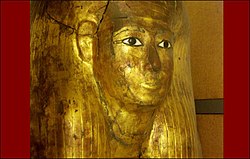TT8
| TT8 | |||
|---|---|---|---|
| Burial site of Kha and Merit | |||

The gilded inner coffin of Kha from his TT8 tomb (now in the Museo Egizio of Turin)
|
|||
| Coordinates | 25°44′N 32°36′E / 25.733°N 32.600°ECoordinates: 25°44′N 32°36′E / 25.733°N 32.600°E | ||
| Location | Theban Tombs | ||
| Discovered | 1906 | ||
| Excavated by | Arthur Weigall and Ernesto Schiaparelli | ||
|
|||
|
← Previous
TT7
Next →
TT9 |
TT8 or Theban Tomb 8 was the site of one of the greatest archaeological discoveries in ancient Egypt. This New Kingdom era tomb was one of the few tombs of Ancient Egypt's nobility to have survived intact down through the centuries - it was only discovered by Arthur Weigall and Ernesto Schiaparelli in 1906 on behalf of the Italian Archaeological Mission. Its discoverers used 250 workers to dig in pursuit of the tomb for several weeks. The pyramid-chapel of Kha and his wife Merit had already been well known for many years; indeed, scenes from it had already been copied by several Egyptologists including John Gardiner Wilkinson and Karl Lepsius in the 19th century. Egyptologists also knew that Kha was an important foreman at Deir El-Medina where he had been responsible for projects constructed during the reigns of 3 kings: Amenhotep II, Thutmose IV and Amenhotep III respectively. The pyramidion of the chapel had already been removed by an earlier visitor and was now in the Louvre Museum.
Therefore, it was a surprise to Schiaparelli that Kha and Merit's burial was located in the isolated cliffs surrounding the village and not in the immediate proximity of the chapel itself as was conventionally the case for other burials of Egyptian nobility. The tomb held the funerary equipment of Kha, the overseer of works from Deir el-Medina in the mid-18th dynasty and Merit.
The items found in the tomb show that Kha and Merit were quite wealthy during their lifetime. Unlike the more chaotic burial of Tutankhamun, Kha's burial had been carefully planned out, the more important items had been covered by dust sheets, and the floor had been swept when the last person had left. The coffins of Kha and Merit had been buried in two nested coffins; Kha's mummy had been tightly wrapped with several items of jewelry included within the wrappings. The two anthropoid coffins of Kha are excellent examples of the wealth and technically brilliant workmanship of the arts during the reign of Amenhotep III. Kha's outer coffin "was covered with black bitumen, with the face, hands, alternate stripes of the wig, bands of inscriptions, and figures of funerary gods [all] in gilded gesso. Meanwhile, Kha's inner coffin was:
Included in one of Kha's coffins is one of the earliest examples of the Egyptian Book of the Dead. An X-ray of Kha's mummy shows that it was "adorned with a gold necklace and heavy earrings, one of the earliest examples yet found of men wearing earrings."
...
Wikipedia

